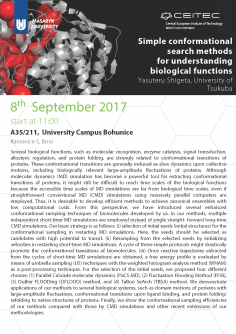Abstract
Several biological functions, such as molecular recognition, enzyme catalysis, signal transduction, allosteric regulation, and protein folding, are strongly related to conformational transitions of proteins. These conformational transitions are generally induced as slow dynamics upon collective motions, including biologically relevant large-amplitude fluctuations of proteins. Although molecular dynamics (MD) simulation has become a powerful tool for extracting conformational transitions of proteins, it might still be difficult to reach time scales of the biological functions because the accessible time scales of MD simulations are far from biological time scales, even if straightforward conventional MD (CMD) simulations using massively parallel computers are employed. Thus, it is desirable to develop efficient methods to achieve canonical ensembles with low computational costs. From this perspective, we have introduced several enhanced conformational sampling techniques of biomolecules developed by us [1-10] (see the review article [1] for details). In our methods, multiple independent short-time MD simulations are employed instead of single straight- forward long-time CMD simulations. Our basic strategy is as follows: (i) selection of initial seeds (initial structures) for the conformational sampling in restarting MD simulations. Here, the seeds should be selected as candidates with high potential to transit. (ii) Resampling from the selected seeds by initializing velocities in restarting short-time MD simulations. A cycle of these simple protocols might drastically promote the conformational transitions of biomolecules. (iii) Once reactive trajectories extracted from the cycles of short-time MD simulations are obtained, a free energy profile is evaluated by means of umbrella sampling (US) techniques with the weighted histogram analysis method (WHAM) as a post-processing technique. For the selection of the initial seeds, we proposed four different choices: (1) Parallel CaScade molecular dynamics (PaCS-MD), (2) Fluctuation Flooding Method (FFM), (3) Outlier FLOODing (OFLOOD) method, and (4) TaBoo SeArch (TBSA) method. We demonstrate applications of our methods to several biological systems, such as domain motions of proteins with large-amplitude fluctuations, conformational transitions upon ligand binding, and protein folding/ refolding to native structures of proteins. Finally, we show the conformational sampling efficiencies of our methods compared with those by CMD simulations and other recent extensions of our methodologies.
Reference
1. R. Harada, Y. Takano, T. Baba, Y. Shigeta, Phys. Chem. Phys. (feature article) 17, 6155-6173 (2015).
2. R. Harada, Y. Shigeta, J. Chem. Theoret. Compt. 13, 1411-1423(2017).
3. R. Harada, Y. Takano, Y. Shigeta, J. Chem. Theoret. Compt. 12, 2436-2445(2016).
4. R. Harada, T. Nakamura, Y. Shigeta, J. Comp. Chem. 37, 724–738(2016)
5. R. Harada, Y. Takano, Y. Shigeta, Chem. Phys. Lett. 630, 68-75(2015).
6. R. Harada, T. Nakamura, Y. Shigeta, Chem. Phys. Lett. 639, 269-274 (2015).
7. R. Harada, Y. Takano, Y. Shigeta, J. Comp. Chem. 36, 763-772 (2015).
8. R. Harada, T. Nakamura, Y. Takano, Y. Shigeta, J. Comp. Chem., 36, 97-102 (2015).
9. T. Baba, R. Harada, M. Nakano, Y. Shigeta, J. Comp. Chem. 35, 1240-1247 (2014).
10. R. Harada, Y. Takano, Y. Shigeta, J. Chem. Phys. 140, 125103 (2014).
About speaker
 Yasuteru Shigeta
Yasuteru Shigeta
Center for Computational Sciences/College of Physics
University of Tsukuba
1-1-1 Tennodai, Tsukuba 305-8577, Japan
Phone: (+81) -29–853-6496 / Fax: (+81) -29–853-6496
E-mail: shigeta@ccs.tsukuba.ac.jp
URL: http://www2.ccs.tsukuba.ac.jp/people/shigeta/shigeta_personal/Message.html
Prof. Yasuteru Shigeta, a Theoretical Chemist and Biophysicist, graduated from Department of Chemistry, Osaka University and obtained Doctor of Science degree at there in 2000. During his doctor course, he was awarded a JSPS Research Fellowship for Young Scientists (DC2), and after graduation, again awarded a JSPS Research Fellowship for Young Scientists (PD). He pursued his postdoctoral researches at Osaka University, Kansas State University, and the University of Tokyo. He worked at the University of Tokyo during 2004-2007 as an assistant professor, University of Tsukuba during 2007-2008 as a lecturer, University of Hyogo during 2008-2010 as a research associate professor, Osaka University during 2010-2014 as an associate professor, and now joined University of Tsukuba as a full professor since 2014. He has published more than 145 scientific papers and received the Presentation award for Young Scientists of the Chemical Society of Japan in 2006, PCCP award of Royal Society of Chemistry (UK) in 2007, Young-chemists award of the Chemical Society of Japan in 2009, the Young-scientists award of Ministry of Education, Culture, Sports, Science, and Technology (MEXT) Japan in 2010, the Young-scientists award of Japan Society for Molecular Science in 2012.








